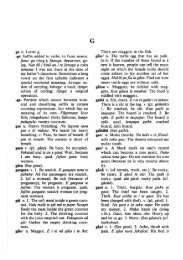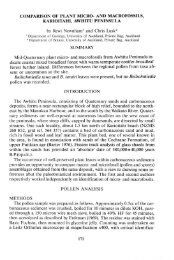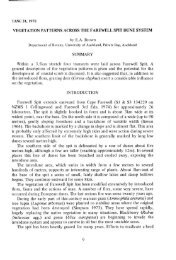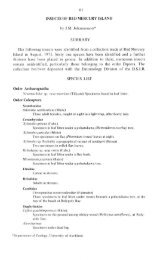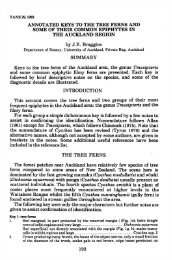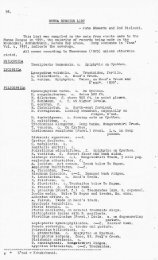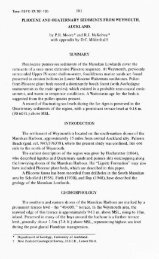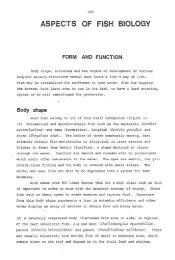METRES - Bookshelf Collection - The University of Auckland
METRES - Bookshelf Collection - The University of Auckland
METRES - Bookshelf Collection - The University of Auckland
Create successful ePaper yourself
Turn your PDF publications into a flip-book with our unique Google optimized e-Paper software.
16<br />
Genesis <strong>of</strong> Whakau Volcanics Clastic Deposits<br />
(a) Breccias<br />
<strong>The</strong> breccias that lie between the flows may be heterogenetic, but the majority<br />
appear to have a direct origin in the lava flows, to which they are petrographi-<br />
cally similar. Moreover, the lava flows were <strong>of</strong>ten observed to lens out and<br />
break up into breccias.<br />
Flows <strong>of</strong>ten have a layer <strong>of</strong> breccia directly above and below, with red<br />
scoria or tuff beds between. <strong>The</strong> authors envisage that the viscous lava broke up<br />
into angular blocks around the margins as it flowed, rafting along and over<br />
riding the breccias, while the slower cooling central portion <strong>of</strong> the flow remained<br />
intact as a coherent mass.<br />
(bj Scoria<br />
In the course <strong>of</strong> mapping, distinction between scoria and breccia was <strong>of</strong>ten<br />
found difficult especially where these were weathered. Consequently, the<br />
symbols used on the stratigraphic columns may not give an accurate picture <strong>of</strong><br />
the distribution and relationships <strong>of</strong> the scoria bands.<br />
Although some <strong>of</strong> the scoria interbedded with flows in the Te Rengarenga -<br />
Koterai-o-maru section may have been directly deposited subaerially, it seems<br />
likely that a proportion was later rafted along by the flows. This hypothesis may<br />
also explain such features as the scoria and breccia pods or lenses in the lava<br />
flows <strong>of</strong> Whakau Point.<br />
At Te Kokowai a sequence <strong>of</strong> scoria bands and thin flows overlying the Te<br />
Kokowai Intrusion appears to be the remnant <strong>of</strong> a once more extensive scoria<br />
cone, presumably built around a centre <strong>of</strong>f Ngatoka Puta Bay.<br />
(c) Tuff Beds<br />
Laminated tuff beds, varying in thickness from 1 cm up to 3 metres, show<br />
few <strong>of</strong> the features typical <strong>of</strong> aqueous deposition and were probably all subaerially<br />
deposited. <strong>The</strong> even distribution <strong>of</strong> ash over such steep sided features<br />
as c' (see structure) makes the idea <strong>of</strong> aqueous deposition unacceptable.<br />
In places these tuff beds are separated into two or even three bands by<br />
lensing lava flows and associated breccias, indicating that they were deposited<br />
from a series <strong>of</strong> ash showers over a period <strong>of</strong> time.<br />
In numerous places the heat <strong>of</strong> the overlying flows has baked the tuff beds,<br />
and in Rolypoly Bay the fine-grained tuffs under-lying flow f (column 2) have<br />
been baked to an extremely hard orange-red brick.<br />
PETROGRAPHY<br />
Specimen numbers are those <strong>of</strong> the petrological collections <strong>of</strong> the Department<br />
<strong>of</strong> Geology, <strong>University</strong> <strong>of</strong> <strong>Auckland</strong>.<br />
Whakau Volcanics<br />
(a) Dykes, Flows and Breccias<br />
Nine representative specimens <strong>of</strong> dykes and flows were selected for thin



